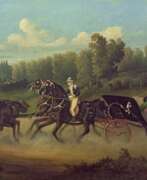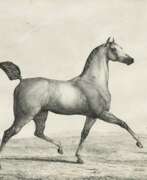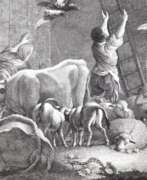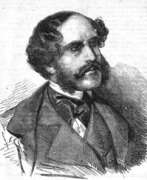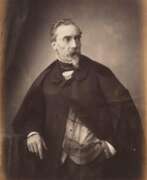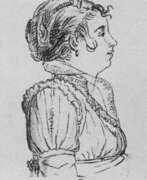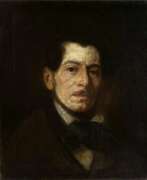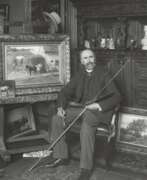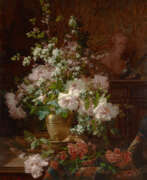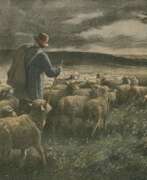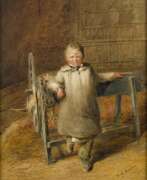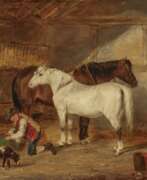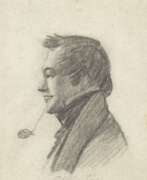Animalists Romanticism
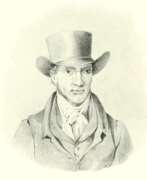

Henry Thomas Alcken was an English painter and engraver chiefly known as a caricaturist and illustrator of sporting subjects and coaching scenes. His most prolific period of painting and drawing occurred between 1816 and 1831.
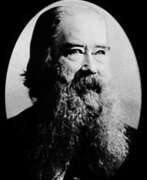

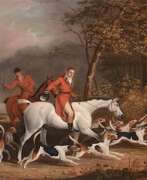

James Barenger is a British animal artist and illustrator.
He was born James Barenger Sr. James Barenger was a metal chaser and naturalist painter. Barenger specialized in depicting horses, dogs, and other animals, as well as noblemen's hunting scenes, which were consistently successful in the 19th century.
Barenger's patrons included the Duke of Grafton, the Marquis of Londonderry and the Earl of Derby. The artist produced entire series of prints depicting hunting, shooting, bullfighting and horse racing, which were published in sporting publications.
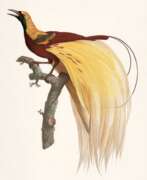

Jacques Barraband was a French zoological and botanical illustrator, renowned for his lifelike renderings of tropical birds. His pictures were based on mounted specimens and his illustration was considered the most accurate ones made during the early 1800s.
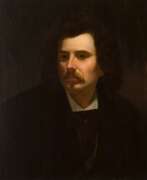

William Holbrook Beard was an American artistic painter who is known best for his satirical paintings of beasts performing human-like activities.
Beard was a prolific artist. His humorous treatment of bears, cats, dogs, horses and monkeys, generally with some human occupation and expression, usually satirical, gave him a great vogue at one time, and his pictures were much reproduced.
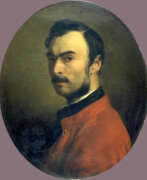

Jacques Raymond Brascassat was a French painter known for his landscapes and animal paintings.
Jacques Raymond Brascassat was a member of the Académie des Beaux-Arts since 1846. Among his pupils was Charles-François Daubigny.
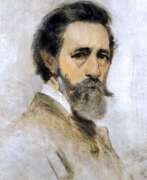

Anton Burger was a German painter, draftsman and etcher. He was a prolific and versatile painter, producing works in almost every genre. His paintings sold very well and, in the area around Kronberg, it was considered a sign of good taste to have a "Burger" in one's home. In 1861, he and Jakob Fürchtegott Dielmann (an old friend from his days at the Städelschule) founded the Kronberg Artists' Colony, where he remained until his death. He was highly regarded and came to be known as the "King of Kronberg".
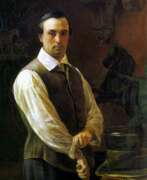

Peter Jakob Freiherr Clodt von Jürgensburg (Russian: Пётр Карлович Клодт фон Юргенсбург) was a Russian sculptor of Baltic German descent, renowned for his significant contributions to Russian monumental art during the reign of Nicholas I. Born on June 5, 1805, in Saint Petersburg, Clodt initially embarked on a military career before pursuing his artistic ambitions. He studied at the Imperial Academy of Arts in Saint Petersburg, where he honed his skills in horse sculpture, eventually earning acclaim from the Emperor himself.
Clodt's most celebrated works include the "Horse Tamers" sculptures on the Anichkov Bridge, unveiled in 1851, and the first monument to a poet in the Russian Empire, the statue of Ivan Krylov in the Summer Garden (1848-1855). His mastery in equestrian statues is evident in the Monument to Nicholas I on Saint Isaac's Square, notable for its technical innovation as the world's first equestrian statue supported solely by the horse's two rear legs. This piece, installed between 1856 and 1859, remains a historic achievement in sculptural engineering.
Clodt's works are celebrated for their dynamic representation and precision in detail, characteristics that have kept his legacy alive in the realms of Russian and European art. His sculptures can be viewed in various prominent locations across Saint Petersburg, serving as cultural landmarks that attract both art aficionados and general tourists.
For those interested in the history of Russian sculpture and the works of Peter Jakob Freiherr Clodt von Jürgensburg, staying updated on exhibitions and auctions can provide unique insights and opportunities. Sign up for updates on new product sales and auction events related to this master sculptor to ensure you don't miss out on valuable collectibles and exhibits.
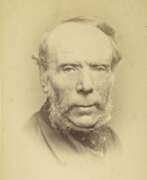

Thomas Sidney Cooper was an English painter. He studied in London at the British Museum and the Royal Academy of Arts.
Thomas Sidney Cooper painted idyllic landscapes and animals in the spirit of the old Flemish masters.


Edwin James Douglas was a British animal painter.
Edwin was the son of the famous portrait painter James Douglas, studied at the Royal Scottish Academy schools and exhibited his first works at the Royal Scottish Academy at the age of only 17. Edwin Douglas painted hunting scenes, dogs and horses, which attracted many famous patrons, including Sir Charles Tennant and Queen Victoria. She even purchased a painting of setters as a birthday present for King Edward VII.
Douglas was a very successful artist whose animal paintings, like those of his predecessor Landseer, resonated with Victorian collectors. He was best at dogs and horses, but he also painted portraits and genre pictures. Between 1869 and 1900 he exhibited at the Royal Academy, forty-one works in all, at the Royal Scottish Academy and other venues in London and the provinces. In addition to painting, Douglas had a passion for cattle breeding and was elected an honorary life member of the Jersey Cattle Society of England.


Robert Eberle was a German painter. He was educated in Konstanz, where he was a pupil of the Swiss landscape and animal painter John Jacob Biedermann. In 1830 he moved to Munich and continued his education with Karl Theodor von Piloti and studied the works of Röysdal and Dujardin.
Eberle was known as a realist painter and quickly gained recognition for his genre scenes and depictions of animals, especially sheep, dogs and poultry. His son, Adolphe Eberle, was also an animal painter.
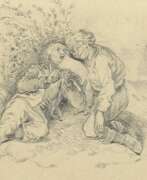

Otto Clemens Fikentscher the Elder was a German painter, draughtsman and illustrator of the Düsseldorf School. Although it is unclear whether he is related to the artist Otto Fikentscher, who was married to Jenny Fikentscher, Otto Fikentscher (the Elder) studied at the Düsseldorf Art Academy and specialised in historical painting and the depiction of horses in battle scenes. He was a member of the artists' association Malkasten and served as a war correspondent during conflicts such as the German-Danish War and the Franco-Prussian War. Fikentscher's works were reproduced in popular magazines and showed his lively and dynamic style.


Henry Garland was a British painter. He was primarily known for his landscape paintings, which often depicted rural scenes of England, Scotland and Wales.
Garland's work is characterised by a romanticised view of the countryside with rolling hills, livestock and tranquil streams. The painter was particularly adept at capturing the atmospheric effects of light and weather in his paintings, and his use of colour was subtle and evocative.
Today Henry Garland is regarded as one of the leading British landscape painters of his generation, and his work is still highly regarded for its sensitivity to the natural world and its depiction of a rapidly changing society.


Friedrich Otto Gebler was a German animal painter.
Gebler studied at the academies in Dresden and Munich and specialized in rural themes and animalistic painting. The main character in Goebler's paintings is sheep, the life of which he studied thoroughly. The sheep graze, rest, worry, there are even expressive portraits of sheep. Contemporary critics have recognized him as the best artist in this subject.
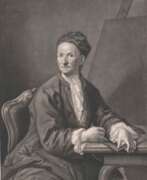

Johann Jakob Haid, a prominent German engraver and portraitist, was renowned for his work in Augsburg during the 18th century. Born into a family of artists, Haid's legacy is particularly noted for his exquisite mezzotint portraits. His career also involved a stint in England, where he was influenced by the works of English mezzotint engraver Robert Robinson.
Haid's artistic prowess was not limited to portraiture. He ventured into botanical illustration, contributing significantly to Johann Wilhelm Weinmann's "Phytanthoza iconographia". This collaboration showcases his versatility and technical skill in different art forms.
Collectors and experts in art and antiques often seek Haid's works for their unique artistic value and historical significance. His contributions to the art world, especially in mezzotint engraving, continue to be appreciated and studied. His works are a testament to the rich cultural and artistic heritage of Germany.
For those interested in the world of art and antiques, particularly in the realm of engraving and painting, Johann Jakob Haid remains a figure of significance. To stay updated on new product sales and auction events related to Johann Jakob Haid, sign up for our updates. This subscription is an excellent way to stay informed about the latest developments and opportunities in the field.
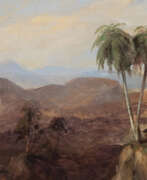

Charles Hamilton, active between 1831 and 1867, was a talented Orientalist painter. Although exact details of his life and work are unavailable, his art profile leaves a mark on art history.
It is known that Hamilton was a recognised master in his field and worked in a variety of genres. His art attracts the attention of collectors and experts, and his works are still highly valued at auctions.
For those who are interested in Orientalist art and want to know more about Charles Hamilton's works, his paintings are of particular interest. Each of his works is a reflection of the era and the artist's individual style, making them significant in the context of art history.
We invite anyone interested in unique artworks and cultural relics to subscribe to our updates. We will keep you informed of new sales and auctions related to the works of Charles Hamilton.


Ludwig Hartmann was a German animal painter.
Hartmann studied at the Academy of Fine Arts in Munich and was a member of the prestigious Munich School of Artists, which flourished during his lifetime, he was awarded medals in Vienna in 1869 and 1872.
The artist's greatest success came from his works with horses, painted in bold colors. But Hartmann specialized in depicting simple, working horses, most often at rest. In his soulful paintings, horses tired after hard work enjoy peace - in the stables or at a watering hole.


Michael Angelo Hayes was an Irish animal and battle painter.
Hayes became best known for large-scale war scenes such as The Lancers Breaking the Square at Aliwal (1846) and The Attack of the Light Dragoons at the Battle of Muddy (1847), where he was able to convey his fascination with depicting the horse in motion.
Hayes spent many years studying with scientific pedantry the movements of the horse in a gallop and eventually published a pamphlet. His work in this area brought significant changes to the technique of depicting horses in painting, which was the subject of much controversy in the mid-nineteenth century. Hayes's innovation made it possible to convey a sense of movement and speed on canvas.
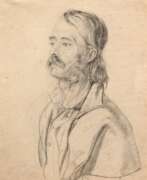

Carl Adolph Heinrich Hess was a German animalist, battalionist and teacher. He studied the works of the old masters at the Dresden Gallery.
Carl Adolph Heinrich Hess travelled extensively in Russia, Hungary, Turkey and Britain, studying different breeds of horses and achieved mastery in their portrayal.
He lived in Vienna from 1808, where he taught at the Academy of Fine Arts. In 1825 he published a collection of life-size lithographs of horse heads.
He was an honorary member of the Berlin Academy of Arts.


Johann Adam Klein was a German painter and engraver.
He studied the art of engraving and painting at the Vienna Academy of Fine Arts, and painted battle scenes, carefully painting details and especially horses. Horses and animals in general are Klein's favorite subjects. In addition to Germany, he lived in Italy and Hungary, and everywhere he looked for subjects for his works, where horses are necessarily in the center of attention, whether it be battle scenes involving the military, or in a village stable on vacation.


Karl Kuntz was a German painter of the late eighteenth and first third of the nineteenth centuries. He is known as a painter, graphic artist and printmaker.
Karl Kuntz specialized in small landscapes and animal images. His works were characterized by fine detail and realism. Kuntz's landscapes reflected real places, sometimes with slight artistic additions. He created images of animals based on Dutch traditions and elevated them to a high level of art. As an engraver, the artist worked mainly in the aquatint technique. In 1829 he was appointed director of the Royal Gallery in Karlsruhe by Grand Duke Ludovic of Baden, but he passed away a year after this appointment.


Martinus Antonius Kuytenbrouwer the Younger was a 19th-century Dutch animalist painter, landscape painter and graphic artist. A court painter for Napoleon III, he was active in Brussels from 1849 to 1860.
The artist's creative legacy is held in museums in Brussels and Rotterdam.
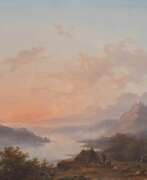

Henry (Hendrik) Lot was a Dutch animal and landscape painter of the Düsseldorf School.
Lot specialised in particular in the depiction of river and forest landscapes on the Lower Rhine, with occasionally identifiable city silhouettes in the distance.
Contemporary critics praised his ability to create images with the simplest means and an "unsought naturalness" in his works. Occasionally his painting was characterised as "in the manner of the old Dutch". From 1854 to 1860 he was a member of the Düsseldorf artists' association Malkasten.


Johan Thomas Lundbye was a Danish painter and graphic artist known for his landscapes of his native country and depictions of animals.
He studied at the Royal Danish Academy of Fine Arts and responded to the call to develop national art by depicting Denmark's characteristic landscapes, monuments and historical sites, as well as its inhabitants.
Lundby's views of mounds, cliffs and coastlines were appreciated - he became one of the national Romantic artists of his generation.
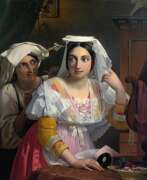

Jan Baptist Lodewyck Maes was a Belgian genre painter active in Italy. Maes studied at the Academy of Ghent. He exhibited for the first time at that city's fair in 1810. He won prizes in all the competitions he entered and in 1820 received a grant from the city of Ghent. Thanks to the Belgian Rome Prize received in 1821, he first visited Paris and then went on to Italy. In 1822 he copied works by old masters in the Uffizi Museum. In 1824 he settled in Rome. Maes kept in touch with his hometown and regularly sent works to Belgian salons. He was a corresponding member of the Royal Netherlands Academy of Sciences.


Balthasar Paul Ommeganck was a distinguished Flemish painter, born in Antwerp, Belgium, in 1755. He garnered acclaim for his unique approach to landscape painting, blending realism with an idealized portrayal of nature. Ommeganck's work is characterized by detailed observation of nature, a sure line, and subtle use of color. His favorite subjects were undulating landscapes, often featuring grazing animals like cows, sheep, and goats.
Balthasar Paul Ommeganck's talent was not confined to painting alone; he was also a skilled draughtsman and dabbled in sculpture, producing some clay models of sheep and cows. His main contribution to art was combining the light found in Dutch Italianate painters' work from the 17th century with meticulous observation of nature, finding a synthesis between realism and an idealized representation of nature.
In 1799, Balthasar Paul Ommeganck's landscape painting won the first prize in Paris, a competition he had not intended to enter but was submitted to by a friend. His success extended beyond the borders of Belgium, as he became a member of several academies, including those in Amsterdam, Brussels, Ghent, Munich, and Vienna. In 1809, he was recognized as a corresponding member of the Institut de France.
Despite his death in 1826, Balthasar Paul Ommeganck's style continued to influence landscape painting in the 18th and early 19th centuries. However, later art critics have sometimes viewed his adherence to classic tradition and preference for the picturesque and conventional as a form of 'hopeless traditionalism'.
For collectors and enthusiasts of art and antiques, Balthasar Paul Ommeganck's works represent a significant period in the history of landscape painting. His paintings, with their fusion of realistic detail and atmospheric beauty, are a testament to his skill and vision.
To keep abreast of the latest news, sales, and auction events related to Balthasar Paul Ommeganck's art, consider subscribing to our updates. This service ensures you stay informed about opportunities to delve deeper into the works of this notable landscape artist.


Matthijs Quispel was a Dutch landscape and animal painter. After graduating, he settled in Dordrecht as a freelance artist. He mostly painted landscapes with grazing cows and sheep. He took part in exhibitions in Amsterdam and The Hague, in Rotterdam and in Groningen.


Henriette Ronner-Knip was a Dutch-Belgian artist celebrated for her detailed and emotive animal paintings, especially cats and dogs. Born into an artistic family in Amsterdam in 1821, Henriette's talent was evident early on, and she quickly became a prominent figure in the art world. Her father, a key influence in her life, helped hone her skills from a young age, emphasizing the dedication required for artistic success. Despite challenges, including her father's blindness and the responsibility of supporting her family, Henriette's resolve only strengthened.
After marrying Teiko Ronner in 1850, Henriette moved to Brussels, where she transitioned her focus predominantly to animals, capturing the essence and character of her subjects with remarkable precision. Her works, such as "The Death of a Friend," not only garnered acclaim but also reflected societal elements, like the reliance on dog sleds in the 19th century. Henriette's contributions were recognized with numerous accolades, and her legacy continued through her children, who also pursued artistic careers.
For collectors and art enthusiasts, Henriette Ronner-Knip's works offer a glimpse into the 19th-century life and a deep appreciation for animal portrayal in art. Her paintings, imbued with a blend of realism and romanticism, continue to resonate, reflecting her profound connection with her subjects and her exceptional skill in bringing them to life on canvas.
To stay updated on available pieces and auction events related to Henriette Ronner-Knip, signing up for updates can provide valuable insights and opportunities to acquire works by this distinguished artist.


Philippe Rousseau was a French painter, acclaimed for his detailed still life and landscape paintings. Born in Paris in 1816, Rousseau's artistic journey was nurtured under the tutelage of Baron Antoine-Jean Gros and Jean-Victor Bertin at the École des Beaux-Arts. Initially venturing into landscapes, his artistry soon blossomed to encompass still life and animal subjects, earning him significant recognition at the Paris Salon from as early as 1834.
Philippe Rousseau's work is characterized by its meticulous attention to detail and a masterful use of light and shadow, which brought everyday objects and scenes to life with remarkable realism. His still lifes, often compared to those of the 18th-century French master Jean Siméon Chardin, demonstrate Rousseau's skill in creating texture and depth, making mundane subjects captivating through his lens. This skill earned him accolades, including medals at the Salon and the honor of being made a Knight of the Legion of Honor in 1852, later promoted to Officer in 1870.
His notable works span from early landscapes to intricate still lifes, reflecting his evolution as an artist. Among these, "Still Life with Ham" and "Still Life with Oysters" are celebrated examples housed in prestigious institutions like The Metropolitan Museum of Art and The National Gallery, London, showcasing his ability to elevate the still life genre to new heights. Another significant piece, "Still Life with Asparagus," illustrates his continued exploration of texture and light, held by the Cleveland Museum of Art.
Philippe Rousseau's legacy lies in his ability to merge the traditional with the innovative, influencing the art world well beyond his passing in 1887. His paintings, rich in detail and steeped in cultural significance, continue to attract art collectors and experts in art and antiques, offering a window into the refined aesthetic of 19th-century French art.
For those captivated by the elegance and historical depth of Philippe Rousseau's work, signing up for updates can provide exclusive access to new sales and auction events featuring his art. This opportunity invites collectors and enthusiasts alike to further explore the nuanced world Philippe Rousseau depicted, ensuring they remain at the forefront of the market for these timeless pieces.


Karl Roux was a German painter of the second half of the 19th century. Lon is known as a painter, the son of the painter Jakob Wilhelm Roux.
Karl Roux began his career with landscapes, as well as depictions of figures on horseback and military scenes, before moving on to idyllic subjects and animal depictions. He found his style in genre painting, depicting folk life. Some of his famous works are: "Riders on the Run", "Goethe's Dorothea driving a harness of oxen", "Plowing a Field in the Early Morning", "Haymaking", "Livestock Sale in Munich" and others.


Francis Sartorius the Elder was a British animal painter.
Francis was the son and pupil of John Sartorius (c.1700-1780), an animal painter and founder of a four-generation dynasty of the famous Sartorius family of artists.
Francis Sartorius was a prolific and popular artist whose main subject matter was horses, racing and hunting scenes. He also collaborated with magazines as an illustrator.
His son John Nost Sartorius (1759-1828) and grandson John Francis Sartorius (1775-1831) were also famous horse painters.


Johann Jakob Schalch was a Swiss painter. He was a contemporary of the Swiss painters Anton Graff, Jean Preudhomme, Angelica Kauffman, Jakob Emanuel Handmann, Johann Caspar Füssli. His son Johann Heinrich Füssli was also a noted painter.
Schalch was noted for his paintings of the Rheinfall in Schaffhausen, many of which were reproduced as engravings, making his name well-known.
The Museum zu Allerheiligen in Schaffhausen owns the largest collection of Schalch paintings and drawings.


August Friedrich Albrecht Schenck was a German and French painter of the second half of the 19th century. He is known as a landscape painter and animalist.
August Schenck created paintings that convey the harmony of nature and man. He became especially famous for his works depicting animals, becoming a sought-after animalist with worldwide recognition. His works are kept in museums in France, Germany, as well as the Metropolitan Museum of Art in New York and the National Gallery of Queen Victoria in Melbourne.


Henri Schouten is a Belgian animalist painter.
He studied at the Brussels Academy, where, under the influence of his teacher Alfred Vervy, he specialized in painting landscapes with cattle. Schouten depicted a wide variety of domestic animals and birds in their natural environment in a very naturalistic way, paying attention to their special character traits, as was fashionable at the time. His paintings were much loved by the wealthy Belgian bourgeoisie.
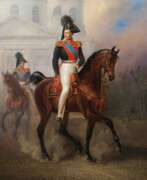

Alexander Schwabe (Russian: Александр Петрович Швабе) was a Russian painter known for his detailed and vivid hunting scenes and animal portraits. Born in 1824, Schwabe became a prominent artist of his time, specializing in depicting animals in their natural settings. His works often featured horses, dogs, and scenes of hunts, reflecting his deep passion for nature and wildlife.
Schwabe's career began with commissions from the Russian Imperial family, which significantly boosted his reputation. He painted numerous portraits of prized horses and hunting dogs for Emperor Nicholas I and other members of the aristocracy. His notable works include "Horses with a Shepherd and a Dog" (1850), "Deer Hunt in the Vicinity of Gatchina" (1860), and "Wolves Attacking a Herd of Horses" (1863). These pieces showcased his ability to capture the dynamic movement and energy of animals in action.
In addition to his paintings, Schwabe was recognized for his academic contributions. In 1861, he was appointed as a professor at the Imperial Academy of Arts, reflecting his influence and expertise in animal painting. His works were frequently exhibited in academic shows between 1844 and 1863, and many of his paintings are now housed in prestigious collections, such as the Tretyakov Gallery in Moscow and the Gatchina Palace.
For collectors and art enthusiasts, Alexander Schwabe's paintings offer a captivating glimpse into 19th-century Russian aristocratic life and their passion for hunting and nature. To stay updated on new sales and auction events related to Alexander Schwabe's works, sign up for our updates.
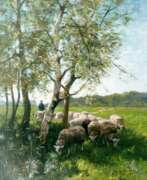

Willem Steelink Jr. was a Dutch painter and graphic artist, associated with the Laren School. He initially focused on portraits, genre scenes and historical paintings, done in a style influenced by the Romantic style of his father. In 1880, he visited the moors around Gooi and began to paint in the style of the Hague School. Together with his friend, Hein Kever, he spent several summers in Laren where he came under the influence of the Laren School, inspired by Anton Mauve. The picturesque village of Heeze became one of his favorite places to work. Sheep, and their shepherds, was his favorite subject. He was also known for his graphic work and etchings, and made copies of famous works by Jozef Israëls and Johannes Bosboom. Later, he did illustrations, mostly for historical works and children's books, but also for an edition of the New Testament in Sundanese. His works were popular and sold well in Germany, England and Canada. He was a member of many artistic organizations, including Arti et Amicitiae and the Pulchri Studio, and received the Belgian Order of the Crown and the French Order of Saint Lazarus.


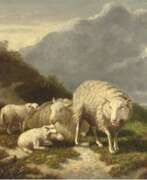

Cornelius van Leemputten is a Belgian animalist painter.
He attended classes at the Antwerp Academy of Art. His main subject was scenes of farm life with shepherds and grazing sheep in a romantic style. Van Leemputten was very industrious and painted many such pictures, as they were in demand among the wealthy public of the time.
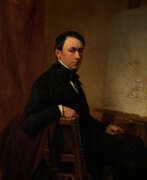

Eugène Joseph Verboeckhoven a Belgian painter, was born at Warneton in West Flanders. He was a painter, a sculptor, an etcher, an engraver, and a lithographer of animals, animated landscapes, and portraits.


Louis-Pierre Verwee or Louis Pierre Verwée was a Belgian painter known for his rural landscapes with cattle and winter landscapes. He is the principal representative of the Romantic school in Belgian landscape painting characterised by a return to nature. His early works are similar to those of his master Verboeckhoven, to the extent that it is often difficult to distinguish their work. Verboeckhoven sometimes painted the figures and animals in Verwee's pictures. Verwee's paintings of forests and rivers are in the stereotypical, romantic way. In the later part of his career he strived for innovation, but from 1837 onwards he became stuck in ever-changing winter landscapes. Louis-Pierre Verwee depicted these landscapes with low-hanging, heavy snow clouds over wintry land and waterways and dotted with figures. He used light blue and metallic gray in his color palette in an effort to suggest the intimate, moody aspect of such landscapes. In some of these paintings Florent Willems and Verboeckhoven painted the figures. He made a number of lithographs after works of Eugène Verboeckhoven.
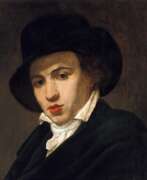

Wilhelm von Kobell was a German painter of the first half of the 19th century. He is known as a landscape painter, animalist and battle painter.
Von Kobell initially produced landscapes and animal paintings, but later focused mainly on battle painting. He visited Vienna and Paris between 1809 and 1810 to study this genre. His battle paintings, based on extensive research, are characterized by striking realism. They are important for the study of military history.
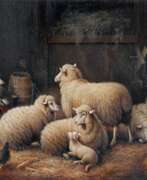

Susan Catherine Moore Waters was an American painter. Her early career in New York state and Pennsylvania focused on portraits. After moving to Bordentown, New Jersey, she specialized in paintings of animals as well as an occasional still life and other subjects.
The works she produced in Bordentown brought recognition in her lifetime. In 1876, Waters was invited to show some of her paintings at the Centennial Exposition in Philadelphia.
